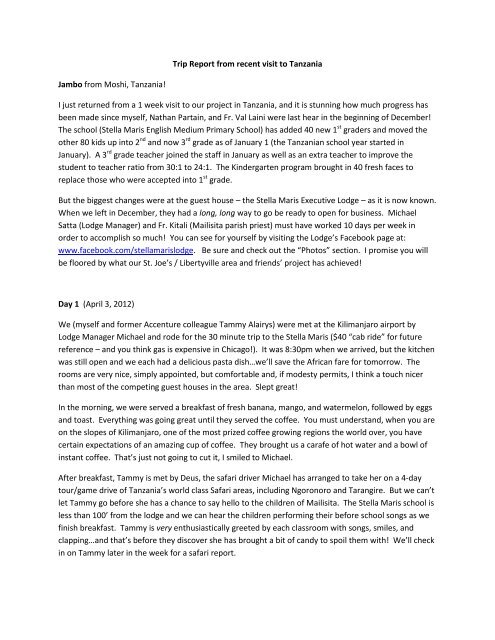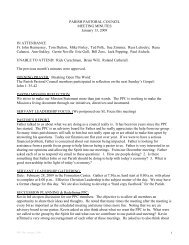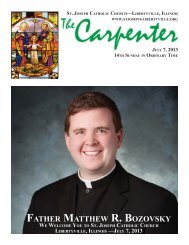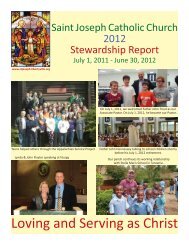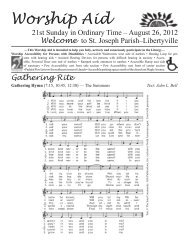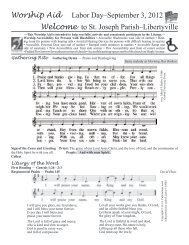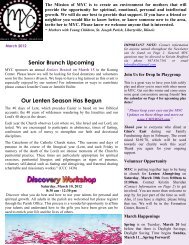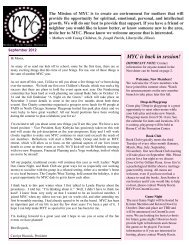2012-04 Trip Report - St. Joseph Parish
2012-04 Trip Report - St. Joseph Parish
2012-04 Trip Report - St. Joseph Parish
Create successful ePaper yourself
Turn your PDF publications into a flip-book with our unique Google optimized e-Paper software.
<strong>Trip</strong> <strong>Report</strong> from recent visit to Tanzania<br />
Jambo from Moshi, Tanzania!<br />
I just returned from a 1 week visit to our project in Tanzania, and it is stunning how much progress has<br />
been made since myself, Nathan Partain, and Fr. Val Laini were last hear in the beginning of December!<br />
The school (<strong>St</strong>ella Maris English Medium Primary School) has added 40 new 1 st graders and moved the<br />
other 80 kids up into 2 nd and now 3 rd grade as of January 1 (the Tanzanian school year started in<br />
January). A 3 rd grade teacher joined the staff in January as well as an extra teacher to improve the<br />
student to teacher ratio from 30:1 to 24:1. The Kindergarten program brought in 40 fresh faces to<br />
replace those who were accepted into 1 st grade.<br />
But the biggest changes were at the guest house – the <strong>St</strong>ella Maris Executive Lodge – as it is now known.<br />
When we left in December, they had a long, long way to go be ready to open for business. Michael<br />
Satta (Lodge Manager) and Fr. Kitali (Mailisita parish priest) must have worked 10 days per week in<br />
order to accomplish so much! You can see for yourself by visiting the Lodge’s Facebook page at:<br />
www.facebook.com/stellamarislodge. Be sure and check out the “Photos” section. I promise you will<br />
be floored by what our <strong>St</strong>. Joe’s / Libertyville area and friends’ project has achieved!<br />
Day 1 (April 3, <strong>2012</strong>)<br />
We (myself and former Accenture colleague Tammy Alairys) were met at the Kilimanjaro airport by<br />
Lodge Manager Michael and rode for the 30 minute trip to the <strong>St</strong>ella Maris ($40 “cab ride” for future<br />
reference – and you think gas is expensive in Chicago!). It was 8:30pm when we arrived, but the kitchen<br />
was still open and we each had a delicious pasta dish…we’ll save the African fare for tomorrow. The<br />
rooms are very nice, simply appointed, but comfortable and, if modesty permits, I think a touch nicer<br />
than most of the competing guest houses in the area. Slept great!<br />
In the morning, we were served a breakfast of fresh banana, mango, and watermelon, followed by eggs<br />
and toast. Everything was going great until they served the coffee. You must understand, when you are<br />
on the slopes of Kilimanjaro, one of the most prized coffee growing regions the world over, you have<br />
certain expectations of an amazing cup of coffee. They brought us a carafe of hot water and a bowl of<br />
instant coffee. That’s just not going to cut it, I smiled to Michael.<br />
After breakfast, Tammy is met by Deus, the safari driver Michael has arranged to take her on a 4-day<br />
tour/game drive of Tanzania’s world class Safari areas, including Ngoronoro and Tarangire. But we can’t<br />
let Tammy go before she has a chance to say hello to the children of Mailisita. The <strong>St</strong>ella Maris school is<br />
less than 100’ from the lodge and we can hear the children performing their before school songs as we<br />
finish breakfast. Tammy is very enthusiastically greeted by each classroom with songs, smiles, and<br />
clapping…and that’s before they discover she has brought a bit of candy to spoil them with! We’ll check<br />
in on Tammy later in the week for a safari report.
Meanwhile, I’m determined to give an unreasonably high priority to resolving “the coffee problem”.<br />
Later that morning, Michael and I drive into the town of Moshi (~15 minutes) and I set out to find a<br />
simple coffee maker and a supply of fresh ground coffee. We find the coffee maker and then head over<br />
to the “Kahawa House” or “Coffee House”. It’s the biggest building in all of Moshi. At least six stories<br />
tall and pretty near a football field wide. It’s the Tanzanian headquarters for coffee processing. Beans<br />
from all over the Kilimanjaro region are brought here, sorted, graded, roasted, and either bulk packaged<br />
for export or packaged for local sale. You can’t get much fresher coffee than that!<br />
We return to the <strong>St</strong>ella Maris with coffee and maker in hand and I work with the kitchen cooks to set it<br />
up and show them how to brew the first pot. I retreat to the dining room and await the results with my<br />
lunch. Splendid!!! I tell this story in part for what happens next. Remember that this fresh coffee thing<br />
is my own little pet project and I buy the coffee maker and coffee out of my pocket, set it up and brew it<br />
myself, but when I get the lunch tab…yep, you guessed it, the bill shows 3,000Tsh ($1.85) for coffee! I<br />
was more than happy to pay and glad to learn that nobody is getting a free cup of coffee from our staff!<br />
Mpaka kesho, (until tomorrow)<br />
Thank you and God Bless<br />
(Asante sana na Mungu akubariki)
Jambo tena from Moshi, Tanzania!<br />
Day 2 (April 4, <strong>2012</strong>)<br />
<strong>Trip</strong> <strong>Report</strong> from recent visit to Tanzania<br />
Coffee issue resolved it was now time to get down to the real purpose of my visit: to ensure that<br />
progress was moving forward on the project.<br />
<strong>St</strong>ella Maris School<br />
Since our last visit in December, as expected, no construction work has occurred at the school. The new<br />
teacher and student desks we ordered were in place (with 40 students sitting two-to-a-desk as in our<br />
other classrooms). I met with the foreman to discuss plans to begin construction of an additional<br />
classroom starting next month for next year’s children. The plan is for them to get the foundation laid in<br />
time for our July volunteers from Libertyville and beyond to do the heavy work of laying 45lb blocks for<br />
the walls.<br />
<strong>St</strong>ella Maris Lodge<br />
The lodge construction and finishing work looks great. In addition to the lobby, kitchen, dining area and<br />
14 guest rooms being in “sell ready” condition, the outside front entrance environment is top notch and<br />
significant work has been done on the 9 top floor guest rooms that we weren’t intending to be ready for<br />
business for a couple of years. All thing in our plan, but several items we didn't expect to get done until<br />
next year when the guesthouse business was established enough to help contribute to its expansion and<br />
improvements. I’m thinking this is fantastic, but also puzzled as to how they managed to get so much<br />
done.<br />
The challenge for years had always been that the project moved too slowly. We made trips partly<br />
motivated by encouraging the team and giving them the confidence on the ground to make decisions<br />
and push forward. Getting the guesthouse built and earning money is the key to the ongoing funding of<br />
the school.<br />
Fr. Augustine Kawishe, Fr. Val’s brother, has from the beginning been both the inspiration for the project<br />
as well as the trusted manager of the project’s finances in Tanzania. I learned during my visit that Fr.<br />
Kawishe’s health has further declined and that he has moved to a priests’ retirement home in the area.<br />
Fortunately, Fr. Kawishe worked with the bishop late last year to appoint Fr. Kitali the new parish priest<br />
for Mailisita. Fr. Kitali is no ordinary priest, but essentially the Diocesan CFO (Chief Financial Officer),<br />
right-hand man of the Bishop, and longtime close personal friend and confidante of Fr. Kawishe. We are<br />
very lucky to have been blessed with his assignment to Mailisita. Our project no doubt played into the<br />
Bishop’s decision.<br />
So how did so much suddenly get done so fast? Well, Fr. Kitali knows how to get things done! That’s<br />
how. He knows how to execute projects. He knows how to knock down barriers to progress. Given his<br />
stature in the broader Moshi community, when he asks for something to happen, it happens that day.<br />
All this amazing progress is wonderful, but does leave us a little bit tighter on funds in the near term<br />
than we had planned (so we’re not out of the fund raising business just yet!), but in the longer term it<br />
will give us a significant boost. After a thorough review of receipts and accounts we decided to slow<br />
down on finishing the top floor 9 rooms and focus instead on getting more customers into the 14 guest
ooms we can sell right now. More later in the week on efforts to drive business to the guesthouse and<br />
what you can do to help!<br />
Worldview Interview w/ Terry Mulligan -<br />
On the home front, did everyone catch the NPR (National Public Radio) story<br />
on the project and Terry Mulligan’s volunteering to teach for the next two<br />
years at our school? You can hear the 12 minute interview at the link below.<br />
The publicity that Terry is generating has already led to some business for the<br />
Lodge and thus, support for the school. www.wbez.org/episode-segments/<strong>2012</strong>-<br />
03-22/global-activism-mailisita-foundation-teaching-kids-tanzania-97542<br />
Mpaka kesho, (until tomorrow)<br />
Asante and God Bless
April <strong>2012</strong> - Tanzania<br />
Hello everyone and a big thanks to <strong>St</strong>an for playing host for my first trip to Africa! I joined him<br />
on somewhat of a whim – a bucket list item to go on safari as I am a bit of both an animal and<br />
photography nut. When the opportunity presented itself on short notice, I jumped at the<br />
chance!<br />
<strong>St</strong>an and I arrived on Monday night, and I was set to go out on safari on Tuesday morning. What<br />
a great way to cure jet lag – I was so excited, I didn’t even notice the 8 hour time change. I<br />
really didn’t have much in the way of specific expectations other than I’d hopefully see different<br />
kinds of animals in their natural environment. I’d heard that old adage that all safaris are<br />
different, but they are all special in their own way and I was ready for an adventure. My<br />
itinerary was set by Deus, a friend of <strong>St</strong>an and Michael’s, and an affable, eagle-eyed Safari guide<br />
who spoke English well. He picked me up in the morning for 4 days of safari covering Tarangire,<br />
Ngorongoro Crater and Manyara National Reserves. Deus selected these three parks due to the<br />
different types of animals we’d be able to see and the time I had available.<br />
I could write an entire book about the experience, but to keep it readable, I thought I’d share<br />
just a few of the memories made along the way.<br />
First animal encounter at Tarangire. - One of the main reasons I decided to go on the trip to<br />
Africa was the time of year – low season (on the cusp of rainy -fewer people, better prices) and<br />
spring time (animal babies!). When we arrived on the first day, we were immediately greeted<br />
by the twigas – giraffes, in Swahili. I spotted a little one, maybe 2-3 years old standing under a<br />
Bilboa tree and I was thrilled! He was barely shoulder height to the other giraffes, but still had<br />
that uniquely giraffe problem where he had to spread his front legs to eat from the ground. I<br />
was both captivated and smiling as I snapped the first shots of more than 1500 total on my<br />
trusty camera.<br />
Of course, we saw many, many animals – Ngorongoro has 20-30,000 within its borders alone –<br />
but what really impressed me was the fact that we could get so close to them. On day two as<br />
we stopped to watch a pack of hyenas (and yes, they do laugh, and make 2 or 3 other distinct<br />
noises as well) battle some lions for food. One lioness broke free from the group, apparently<br />
either full or annoyed with the hyenas, and headed to the top of a nearby mountain. I was<br />
snapping away on my Nikon figuring that was as close as I was going to get. We shut the car off<br />
and sat to watch her as she lay down on top of the hill. My trusted guide Deus suggested we<br />
just wait a bit to see what she’d do – we were sitting between her and a river, and he thought<br />
she might just come down for a drink. Sure enough, after about 10 minutes, she got to her feet<br />
and started walking toward us. My heart was beating pretty fast by then. We drove along a bit<br />
and she came right up alongside the truck!<br />
I was snapping about 10 pictures a minute– knowing that this kind of close up interaction is<br />
pretty rare. We watched as she crossed in front of the car, got a drink from the stream, hopped<br />
over the stream, climbed a tree and then ultimately came back to our side of the river and laid<br />
down within 10 feet of our truck. This was an amazing encounter, one that I will not soon<br />
forget, especially as she looked directly into my eyes as she passed by the car. Wow!
In another encounter, we had stopped the car to look at some baboons crossing the road in<br />
front of us. With literally no warning there was a loud Crash! On the side of the road and out<br />
walked a full family of elephants – mother, father, older sibling and a baby – maybe a year or<br />
two old. I was stuck by the beauty and power of these animals – nothing stands in their way.<br />
They walk 24 hours a day, eating almost constantly. Most entertaining, the baby stopped<br />
midway through crossing the road to look directly at us, flaring her ears and curling her trunk.<br />
Then off they went, crashing their way through the brush on the other side of the road and it<br />
was quiet again.<br />
We had a funny interaction with some Masai children as well. The boys are responsible for<br />
herding cattle and goats from a very young age, and they often walk the animals along the side<br />
of the road. Driving to Tarangire, we saw what looked to be a bump in the road – but upon<br />
further inspection, it was actually large tortoise. I asked Deus to pull over so I could snap a<br />
picture, and when we did, several Masai kids ran out from the field to greet us. It was then we<br />
realized the tortoise was a ‘plant’ and I have a personal credo that doesn’t allow me to pay for<br />
photos I take, so we passed on a tortoise picture. However, two days later on our way back, lo<br />
and behold, a lump in the road again! That same tortoise was crossing. This time, however, we<br />
were better prepared. With some leftover fruits, biscuits, and juice from our box lunches, we<br />
were able to make an impromptu deal with the kids – food for pictures. They were all smiles<br />
and happy for the exchange, and I got a great shot.<br />
Safari for me was an amazing experience, fulfilling a lifelong dream and a real opportunity to see<br />
how animals live and interact in the wild. I’d suggest anyone who has the chance take it – even<br />
if you’re not a real photography nut, seeing the animals in their natural habitat is something you<br />
will never forget.<br />
For more safari photos, check out my Flickr site at:<br />
http://www.flickr.com/photos/77114820@N05/6924350088/in/set-72157629800310975/<br />
Tammy Alairys


